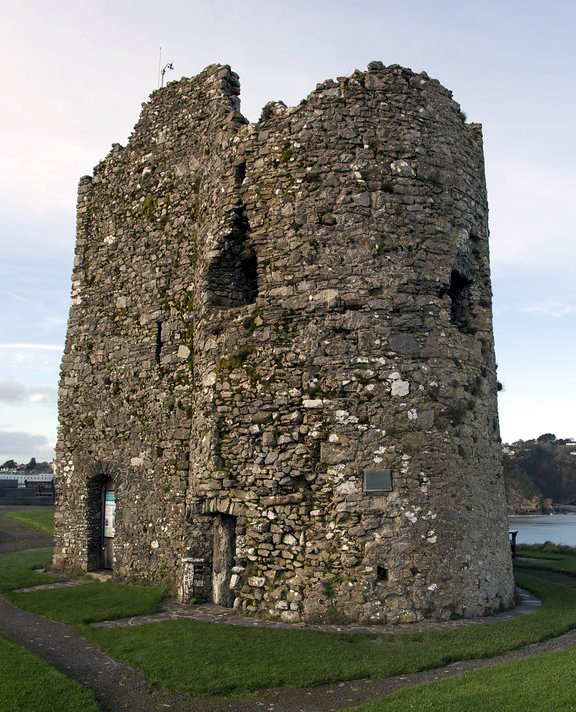Tenby
Tenby castle stands on a rocky promontory 500' long by 150'
to 300' wide. St Catherine's fort stands on an island just to
the south-east. Occupation of the near island on which the castle
stands quite obviously started early. Roman coins of the
first century AD have been found on the site and from the third century
on St Catherine's island. A Welsh poem of no later than 875
AD mentions the fort of Dinbych and the tenth century book of Taliesin,
who is claimed to have died around 599 AD, describes Bleiddudd as lord
of ‘the fair fort on the coast'. The implication of
the poem may be that the fort was held by the Irish and that they were
hostile to the Deheubarthians and defeated a Venedotian warband who
came to attack them.
The castle proper was first mentioned in 1153 when it was taken by the
Welsh princes of Deheubarth in their attempt to turn back the conquest
of 1093. The implication is that the castle was probably
built as a fee of Pembroke lordship in the late eleventh
century. The castle was soon retaken from the Welsh, but fell
again in 1187 to Maelgwn ap Rhys (d.1230). There then
followed nearly a century's peace, with the first recorded constable of
the fortress mentioned in 1231. The castle fell in 1260 to
forces loyal to Prince Llywelyn ap Gruffydd (d.1282). The
inquisition of 1386 on the death of John Hastings of Pembroke, noted
that Tynbegh
castle was in disrepair and contained a lord's chamber, a horse-mill
and a ‘tripget'.
The castle and town were garrisoned for King Charles I (1625-49) in 1643 and was taken
after a siege from 7 to 10 March. It was then held for
Parliament throughout the first Civil War, but was taken for the
Royalists and held for 10 weeks in 1648, Cromwell writing on 21 May
that:
‘the reduction of Wales is more difficult than was
expected; the towns and castles of Pembroke and Tenby being equal to
any in England and well provided of all things'.
The keep was
built/converted into a look out tower in 1818 when the coastguard boat
house was built. Finally, in the 1860s, the castle was
converted into a National Memorial Park for Prince Albert.
Description.
The castle is entered from the south via a spit of land coming from the
fortified town to the west. Aerial photographs suggest that
an inner curtain ran around the summit of the hill. This is
now merely a low earthwork. A second wall ran across the neck
of the headland and along the cliff top around the near island, but
this is now very fragmentary. The best surviving piece is to
the north. This has ground floor crossbow loops and a
wallwalk, making it somewhat similar to the town walls and the castles of Dunamase and
Grosmont. Three other towers have been recorded, but their
positions are now lost. To the south there is another
fragment of wall attached to the entrance which consists of an
elongated D shaped barbican with a rectangular gatetower within at
right angles. This mimics the entrance at the Five Arches of
the town walls and is somewhat similar to the gate at
Caldicot. East of this is a complex of buildings about 110'
long by 65' deep. This has been the town museum since 1878
and was possibly the original castle hall block. Certainly it
was shown as a roofless, gabled domestic building in the early
nineteenth century.
On the height of the headland are the remnants of the smallest keep in
Wales. This round tower is only 19' in diameter and has walls
only 5' thick. As such it is the smallest round keep in the
country. The tower also tapers towards the
top, as do some of the towers at Kidwelly, while its apertures seem to have all been much abused. On its west side is an added rectangular stair
turret which more than doubled its size and gave access to the roof.
Why
not join me at other Lost Welsh Castles next Spring?
Please see the information on tours at Scholarly
Sojourns.
Copyright©2019
Paul Martin Remfry
